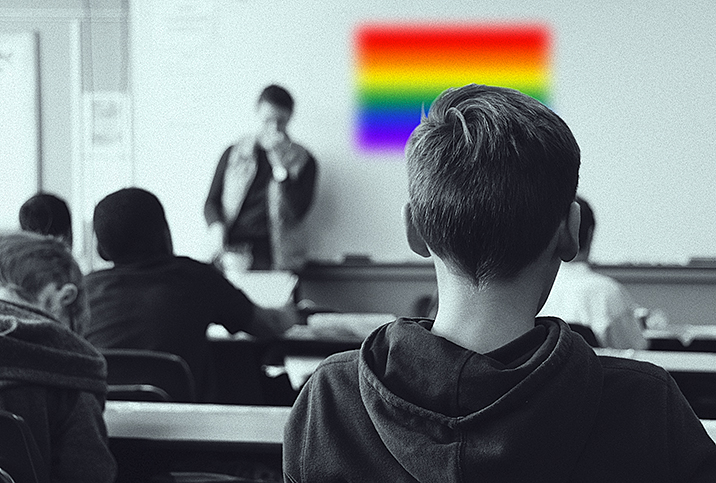How to Bridge the LGBTQIA+ Gap in Sex Education

Sexual health education in the United States is sorely lacking in several categories, but it particularly overlooks people who do not identify with heteronormative sexual interests or traditional gender identification models. It's more than just an issue of not being included; when it comes to safer sex, LGBTQIA+ individuals face specific challenges for which the education system completely fails to prepare them.
You might know that HIV and AIDS tend to be more commonly contracted by men who have sex with men, but are you aware of the specific biological and viral aspects of why? Young men receiving sex ed in America certainly aren't, and that lack of information and knowledge will only make the spread of HIV more aggressive.
Similarly, many people hold the belief that sexually transmitted infections (STIs) cannot be transmitted from woman to woman, or in any couple where no partner has a penis. This is not true. And if a woman believes she's safe from STIs because she's having sex with another woman, she may not use appropriate methods of protection and will therefore be at higher risk. In addition, some studies suggest that bacterial vaginosis may be more common in women who have sex with women.
Relevant to these sexual scenarios is the importance of access to and understanding of various protection methods, especially barrier methods, during sexual activity. Many states do not require comprehensive education regarding the use of STI protection during sex, or they allow parents to prevent their children from gaining access to this type of information, regardless of the child's interest in the subject.
Improvements in these areas are clearly necessary but face many hurdles, including the risk of legal repercussions for educators and school districts.
Obstacles to knowledge
As recently as 2020, seven states still had legislation in place that either barred educators from discussing topics related to LGBTQIA+ sexual health or forced them to frame such topics in a negative light. (LGBTQIA+ stands for lesbian, gay, bisexual, transgender, queer, intersex, asexual + anyone else who feels part of the queer community.)
Additionally, requirements for discussing topics like HIV and AIDS as they pertain to sex, as well as a number of other topics of particular importance to all young people, vary widely from state to state. Opportunities to provide vital information freely and without fear of consequence are often impeded by additional legislation that vaguely requires educators in 26 states (plus the District of Columbia) to make the content of such lessons "age appropriate."
Appropriateness, in the legal sense of these particular matters, serves as a sort of conduit for selective censorship. Since political climates vary state by state and county by county, educational oversight committees and local governments are able to censor educators from sharing potentially lifesaving information with students by deciding that such information is age inappropriate.
But sexual activity and exploration are nearly inevitable, so this limitation of educational discourse and resources is incredibly harmful and, it's no exaggeration, potentially deadly.
Mind, body, spirit
Sex ed is not just a matter of physical or biological health: Mental and emotional health factors play an immense role in the holistic sexual health of any individual. This is particularly important for populations of all ages who are prone to experiencing harmful discrimination, marginalization and ostracization from their own families or communities.
It's impossible to quantify how sexual health is affected by dialogue and education. Young people especially need to establish a healthy relationship with their gender and sexual identity in order to avoid future emotional problems. Sadly, for many young people, including LGBTQIA+ teens, American schools are still objectively unsafe and unhealthy locations for teens to explore and define their identity.
Emotional and mental health resources, as well as education about physical health, need to be improved in schools. In fact, as educators are able to become more inclusive and provide a more expansive library of information to students, they will increasingly be in need of resources for discussion, questions and investigation outside the classroom.
All children experience controversy and conflict among their peers; adults should be prepared to guide students through these conversations. When it comes to matters of sexual, emotional and mental health, it's not enough to present materials and let students do as they will. It is far too easy for adults within and outside of education sectors to disregard the role they play in the healthy development of identity for young people.
It's equally important to examine how adults support one another in discussions and education surrounding gender and sexuality. If students in modern classes aren't learning about LGBTQIA+ health, adults who grew up in less-accepting times certainly didn't, and catching up on what they missed is critical to helping students learn successfully.
Where do we go from here?
The largest hurdle for comprehensive LGBTQIA+-inclusive sex education is legislation. However, it is of equal importance that educators—who themselves have most likely suffered from the historical inadequacies of sex education—are able to access better resources, so they can adequately teach these subjects.
Therefore, it is not enough that sex-ed improvements flow from adults down to adolescents. We need to create a better informational infrastructure in this country that allows people of all ages and identities to learn and discuss critical health information. To tackle the issue of sexual education in the United States, it's necessary that adults encourage each other to learn about LGBTQIA+ issues and support each other through the process.
Educational expansion and enhancement will not happen overnight or even in the course of years. It will most likely take decades or even longer. Now is the time to start.
Fortunately, many online resources are available to do just that. Try The Trevor Project, GLAAD, The Safe Zone Project and others.


















